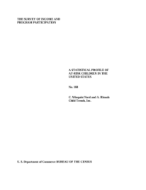A Statistical Profile of At-Risk Children in the United States
A Statistical Profile of At-Risk Children in the United States
Introduction
The Survey of Income and Program Participation (SIPP) is an ambitious data collection effort that to date has been under-used by researchers. Although there are many reasons why researchers choose not to work with SIPP, one reason often given is that the sample size is too small to make reliable estimates, particularly for selected subgroups of the population. If other data sources, such as the Current Population Survey (CPS), are available that provide similar data, researchers often choose to work with these other data instead.
In an earlier paper, we evaluated SIPP as a source of data on children by comparing estimates derived from SIPP with estimates derived from several other sources including the CPS (See Nord and Rhoads, 1991). In particular, we compared estimates of the percent of related children under 18 in poverty by age and race, the percent of children under 6 who are poor or near poor by selected family and parental characteristics, and the percent of families receiving AFDC derived from the 1986 panel of SIPP with estimates derived from the CPS, the National Integrated Quality Control System, and the 1988 Child Health Supplement to the National Health Interview Survey. With a few exceptions, we found that the estimates derived from SIPP were very close to the estimates derived from the other sources. we noted that as the population became more narrowly defined, the estimates from SIPP did begin to deviate from the other sources. Thus, we speculated that SIPP's smaller sample size relative to the CPS may indeed hinder its usefulness in studying specific groups that occur relatively rarely in the population.
In this paper, we continue to explore whether SIPP provides reasonable estimates of the child population by comparing estimates derived from SIPP with estimates from the Current Population Survey. Specifically, children living in families receiving AFDC, children living in families that are poor, but not receiving AFDC, and children living in near-poor families (those with incomes below 150% of the poverty threshold) are compared with children living in nonpoor families and with all children in the United States on some basic demographic variables and by selected characteristics of their parents.
In addition, we create a profile of children in America who are at-risk of adverse outcomes because of living in welfare families, living in or near poverty, or living with a mother who began childbearing as a teenager. For this profile, we describe in more detail the estimates derived from SIPP and present additional data from SIPP that are not available in the March CPS. Thus, selected demographic and parental characteristics of children living in families receiving AFDC, those living in poor families that are not receiving AFDC, and children living in near-poor families are described and contrasted with children who are not poor and with all children in the United States. In addition, children born to women who began childbearing as teenagers are compared to children born to older mothers and to all children in the United States. The March CPS does not contain information on women's ages at first birth, thus it is not possible to use the CPS to examine children born to teenage mothers.
Before making the comparisons between the SIPP and the CPS and developing the profile of at-risk children, the design and objectives of SIPP and of the CPS are briefly described.
Others in Series
Working Paper
Working Paper
Working Paper




